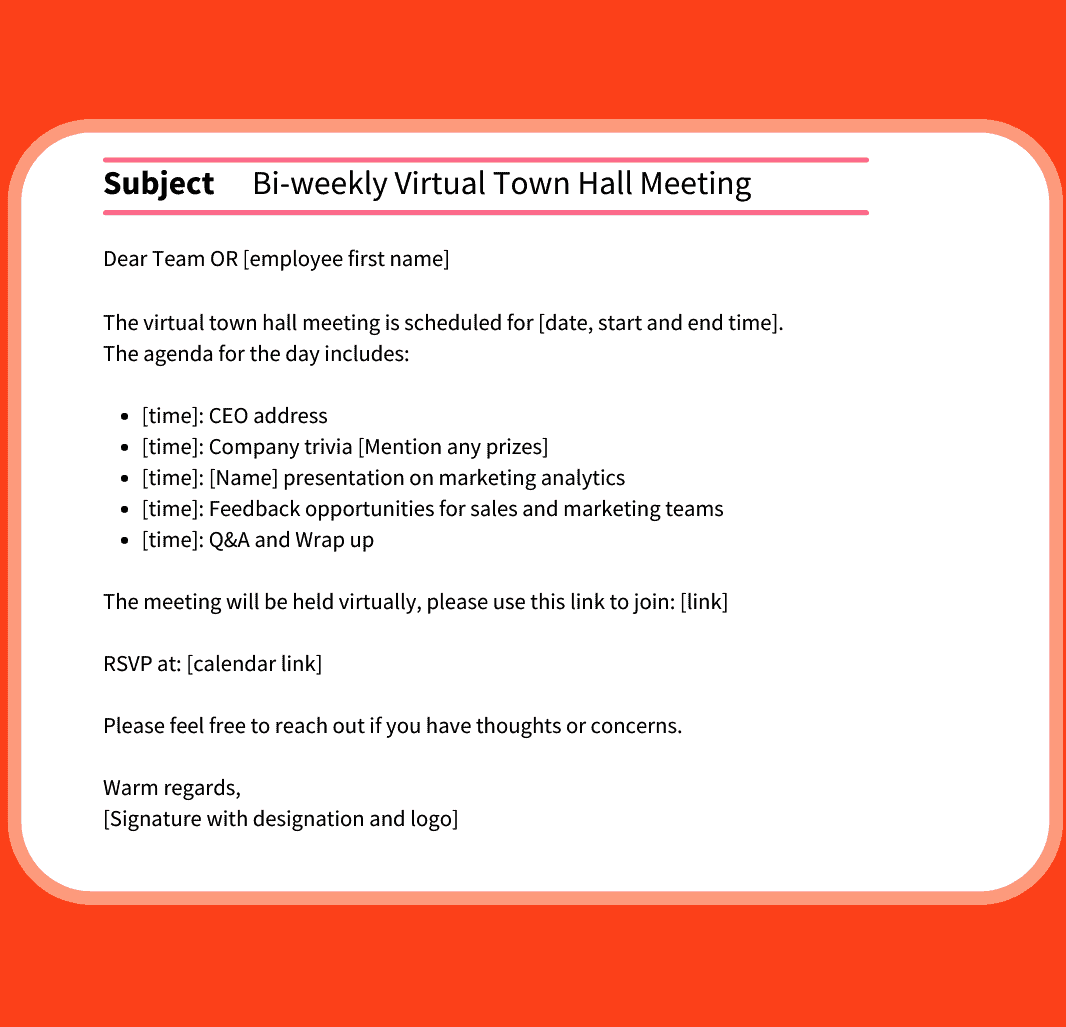In today’s world, where remote work is the norm and efficient communication is paramount, video conferencing holds tremendous importance. It has become an incredibly versatile tool, applicable in various situations, and its affordability makes it even more attractive.
In this in-depth guide, we’ll take a deep dive into the world of virtual meetings, exploring their many uses, sharing valuable tips, and demystifying the technology behind them. Whether you’re a seasoned pro or just starting your virtual meeting journey, our goal is to provide you with the knowledge and skills to navigate this ever-changing landscape effectively.
Chapter 1: Virtual Meetings Fundamentals
What is a Virtual Meeting?
Virtual meetings take place online, creating a virtual environment where people can interact, collaborate, and engage without the need for a physical meeting location. In essence, it’s a virtual gathering of individuals coming together to share ideas, experiences, and conversations.
One of the significant advantages of virtual meetings over in-person ones is their accessibility. They break down geographical barriers, enabling participants from different corners of the world to join in without the necessity of traveling to a specific venue. These meetings can take various forms, including video conferences, text-based chats, or audio discussions, offering flexibility in how people connect and communicate.
Importantly, online meetings promote inclusivity. They ensure that everyone, regardless of their physical location, can actively participate in important discussions and contribute to the collective goals and decisions of the group or organization.
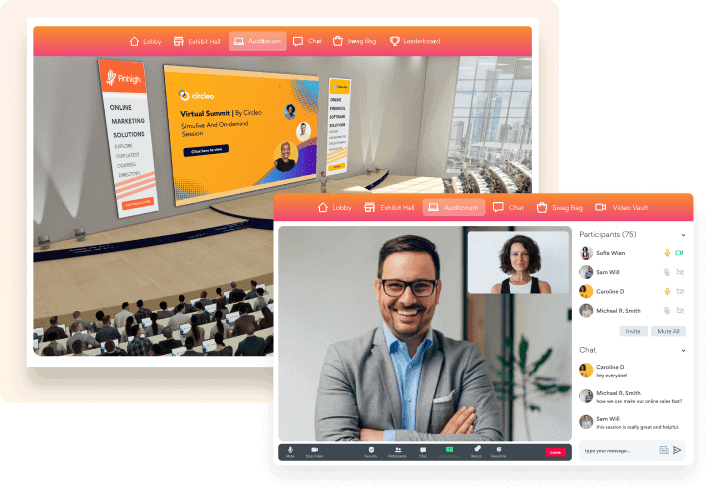
Difference Between Virtual Meetings & Virtual Events
A virtual event focuses on your customers or target audience. It includes multiple sessions and activities to keep a host of attendees engaged. It could be hosted through a conference, trade show, job fair, or education fair platform.
However, a virtual meeting is largely an internal event. It is usually for the sake of a company or organization to collaborate within itself, such as an annual review or a town hall. However, it need not be limited to just that. A virtual meeting can be between intergovernmental agencies or world leaders as well.
Chapter 2: Types of Virtual Meetings
Numerous meeting formats exist, and to shed light on this diverse landscape, vFairs consulted their seasoned HR manager. Below, you’ll find a thorough list of meeting types, designed to assist you in identifying the one that aligns most compassionately with your unique requirements.
Internal Meetings
1. Town Halls
Town Hall meetings are gatherings for the entire company and can occur on a biweekly basis. Their primary objective is to establish a connection with employees and disseminate updates from various teams and departments. Typically spearheaded by team leaders or any individual closely associated with a particular update or project, these sessions offer a platform to celebrate occasions such as birthdays, work anniversaries, and employee achievements.
Furthermore, Town Hall meetings provide an excellent opportunity for interactive activities like games and wellness initiatives, whether focusing on mental or physical well-being. They serve as a valuable barometer for gauging overall employee morale and contribute significantly to fostering a sense of community within the organization.
2. Retros
Retrospective meetings occur at the end of a project to help teams pause and think about improving future performance. It’s a safe space for reviewing the project’s successes, identifying opportunities for process improvement, and solving issues that may have come up. Usually, managers do not attend these meetings.
3. Huddles & Sync-ups
Huddles commonly take place daily, weekly, or biweekly. Teams utilize these huddles to connect on daily tasks and team goals. The purpose is to set priorities, manage everyone’s tasks and schedules, and share any information.
4. Friday Game Days
“Game days” represent team-driven endeavors, fostering camaraderie through casual interactions and virtual games like Pictionary, Two Truths and a Lie, trivia, and more. These gatherings follow two straightforward principles: 1) prioritize enjoyment, and 2) leave work-related discussions at the door.
5. Pulse Check-Ins
Pulse check-ins involve HR personnel meeting with employees to assess various aspects, including satisfaction levels, performance analysis, engagement, support requirements, and overall morale.
6. Onboarding Sessions
These sessions are designed to brief new employees. You can show them around the virtual workspace and show them how you work. It is to help them ease into the workspace and get acquainted with the work culture.
7. All Hands
These are company-wide meetings held quarterly. Commonly led by the CEO and leaders, the purpose is to share new quarterly goals for each team and report on the past quarter’s goals. This helps teams understand how you measured up against the last quarter. You can also conduct engagement and team-building activities.
8. Fireside Chats
This is an optional meeting where the organization invites an external thought leader, customer, celebrity, author, or influencer. This individual coincides with an active company goal, mission or value. The speaker is usually interviewed live by an internal member and has questions gathered beforehand by employees who are interested in learning about something specific.
9. AMAs (Ask Me Anything)
This is another optional meeting where a leader, founder, or CEO of the organization is interviewed by everyone within the organization. Common topics include the vision of the company, revenue, personal hobbies, or passions.
10. Lunch and Learns
This is an employee-initiated meeting that happens ad hoc. The goal is for an employee to share a new process, a new tool, a new technology, or a product feature with the entire team.
11. Skip Level Meetings
A remote meeting where the manager invites employees for a session with direct reports to discuss feedback and conduct a performance analysis of the team and ideas.
12. Roundtables
Roundtables are led by the CEO, and intended to bring together employees from diverse teams, backgrounds, and locations. The aim is to foster inclusivity and a rich exchange of ideas.
Each roundtable centers around a specific theme, such as “Exploring the vFairs platform’s gamification feature” or “Navigating the challenges of remote-first work environments.” During these sessions, employees have the opportunity to share their valuable insights, whether it be their personal experiences, client feedback, or individual perspectives.
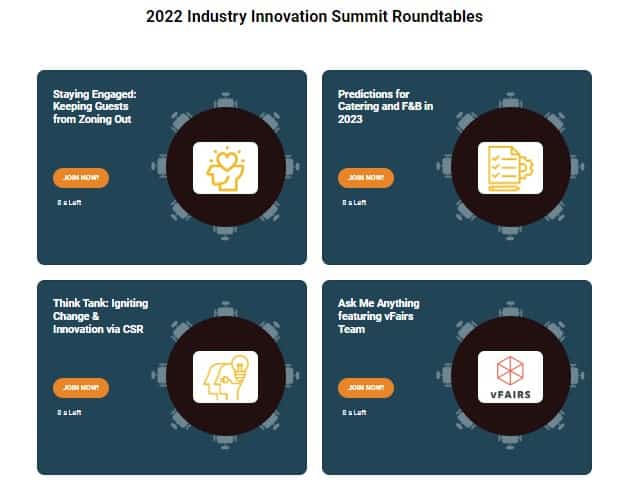
13. Individual Meetings (1:1s)
These private meetings occur between a manager and their direct report, fostering open discussions about feedback, performance, priorities, challenges, and achievements. The typical practice involves holding individual meetings with each direct report on a weekly basis.
14. Mediations
These sessions involve HR facilitating communication between two or more employees in need of assistance. HR serves as a mediator, aiding employees in navigating the dialogue and steering them toward a constructive and mutually beneficial resolution.
15. Brainstorming & Working Sessions
This is an ad-hoc session that gathers the contributors of a project or initiative to work together on a virtual meeting. The purpose of this type of meeting is to get creative, identify roadblocks, and play out a situation to see if it is sustainable and scalable.
External Meetings
1. Retros
Much like internal retrospective gatherings, an external retro entails a pause in operations for both customers and the project team to collectively reflect on future performance. During this process, the project’s accomplishments, areas for enhancement, resolution of issues, and the formulation of fresh plans all take center stage.
2. Quarterly Business Reviews
During a QBR, the client service representative guides a discussion regarding the extent to which the company fulfilled or fell short of customer expectations. This session also serves as a platform to examine forthcoming product features, and upcoming events, and to find fresh prospects for growth and improvement.
3. Event Planning
This gathering brings the team together to prepare for an upcoming event. During this session, participants collaboratively strategize event logistics, establish action items, define expectations, and brainstorm ways to deliver an unforgettable experience.
4. Demo
A demo is a meeting scheduled between your organization and a potential client with the purpose of illustrating the worth of your product or service, and illustrating its applicability to the customer’s objectives.
5. Follow-ups
In these meetings, your company’s employees engage with customers to revisit and address pending actions, tasks, or unresolved issues. These meetings serve as a crucial touchpoint for ensuring that customer needs are met, questions are answered, and concerns are adequately addressed.
6. Interviews
During interviews, hiring managers converse with prospective candidates applying for roles within the organization. These discussions aim to assess the qualifications, skills, and suitability of candidates for specific positions within the organization.
Chapter 3: Advantages & Disadvantages of Virtual Meetings
Advantages
1. Convenience
Embracing virtual meetings means embracing unparalleled convenience. Instead of meticulous preparation, you can swiftly resolve issues by reaching out to your team and hopping into a virtual meeting. This simplicity surpasses the hassle of finding physical meeting spaces, coordinating participants, and gathering in one place.
2. Reduced Expenditures
Virtual meetings strip away the need for excessive expenses. All that’s required is a stable internet connection and a computer or mobile device for access. No more bearing the brunt of travel costs, food expenses, or rental fees for physical spaces. This cost-saving approach leaves room for investments in other essential tools for your organization.
3. Low Carbon Footprint
In a world grappling with the imminent threat of climate change, businesses must reconsider their strategies. The carbon footprint, encompassing greenhouse gas emissions from employee travel and building energy consumption, can be significantly reduced through virtual meetings.
4. Greater Flexibility
The future, if not entirely virtual, is certainly leaning in that direction. As a result, hybrid event formats will become increasingly necessary to accommodate diverse preferences. Some employees may continue to work remotely, while others may opt for physical interactions by returning to the office.
Virtual online meetings offer the flexibility to cater to these diverse needs, ensuring that work doesn’t come to a standstill. Virtual event providers are already offering solutions that are applicable in various ways, making meetings interactive and incorporating gamification elements in both physical and virtual settings.
5. Time Savings
Virtual event management platforms like vFairs provide end-to-end project management, relieving you of the burden of event planning. A dedicated project manager and their team handle everything from initial planning and creation to execution, technical support, and post-event analytics. By delegating these tasks, you free up your time for other critical responsibilities.
Disadvantages
1. Setup Expenses
For small businesses or non-profit organizations, the cost factor can be a significant consideration when it comes to virtual meetings. The setup and planning of a virtual meeting can entail expenses, particularly if you aim for a more elaborate setup.
Nevertheless, platforms like vFairs are committed to accommodating your budget constraints. The all-in-one event platform lets you tailor your event to your preferences and utilize the features you need. Their dedicated project management team will help you make the most of relevant features tailored to your objectives, all while keeping a close eye on your budget. In any case, these online meetings tend to be more cost-effective than their physical counterparts.
2. Sustaining Participant Engagement
Maintaining participant engagement during virtual meetings can be a daunting task, especially when the meeting has specific goals to achieve. How do you ensure that attendees remain engaged without diverting from the meeting’s purpose?
Fortunately, virtual event platforms like vFairs offer a range of engagement tools designed to keep participants actively involved. You can incorporate interactive elements such as polls and Q&A sessions to encourage attendee input. Additionally, features like trivia and spin-the-wheel can inject an element of excitement into the meeting, making it more engaging for everyone involved.
Chapter 4: Virtual Meeting Preparation
Virtual meetings have become an integral part of modern workplace communication. However, effective preparation is key to ensuring that these meetings run smoothly and achieve their intended objectives. In this chapter, we’ll explore essential tips and considerations to help you prepare for successful online meetings.
Assessing Tools and Collaboration Platforms
Empowering Employee Choice
When deciding on the most suitable collaboration tools and platforms for your organization, involving your employees in the decision-making process is crucial. To begin, consider conducting cross-department surveys and polls. Gather insights on which tools your employees prefer and which vendor features align with their needs. This ongoing assessment ensures the adoption of technology that best serves your organization.
Enhancing Employee Experience
Invest in Training and Onboarding
Creating a positive employee experience starts with comprehensive training and onboarding, especially when transitioning to new technologies. Recognize that employees may not be familiar with all aspects of these tools, whether it’s shifting from one software suite to another or adapting to new devices and platforms. Invest in training and one-on-one support to bridge these knowledge gaps effectively.
Meeting Employee Needs
Anticipate the needs of your employees. Consider providing necessary equipment like noise-canceling headsets and additional monitors to enhance their virtual meeting experience. Reliable internet connections and other technical resources should also be readily available to support seamless participation.
Optimizing Meeting Setup
Effective Lighting
A well-lit environment ensures that you appear professional and easily visible during online meetings. Adequate lighting that complements your screen’s display is essential for clear communication and maintaining a professional image.
Scheduling Considerations
Coordinate Schedules
To ensure all participants can attend, carefully schedule your virtual meetings. Take into account the availability and time zones of all involved parties. Utilize shared calendars, tools like Calendly, or scheduling platforms like HubSpot to streamline the scheduling process and accommodate participants’ preferences.
Establishing Meeting Objectives
Define Meeting Objectives
Every meeting should have a clear purpose and objectives. Determine what you aim to achieve, whether it’s problem-solving, goal-setting, gathering feedback, or brainstorming. Creating a well-defined meeting agenda ensures that participants are aware of the meeting’s goals and can come prepared with valuable input.
Share the Agenda
Share the meeting agenda through a designated landing page provided by your platform. This step ensures that participants understand the meeting’s structure and objectives, promoting engagement and inclusivity.
Sending Invitations
Crafting Invitation Emails
Once you’ve scheduled the meeting and finalized the agenda, it’s time to invite participants. Your invitation email should be concise and informative, covering essential details. Follow these steps for an effective invitation:
- Clear Subject Line: Use a subject line that conveys the purpose of the meeting.
- When and Where: Reiterate the date, time, and platform details in the email.
- Duration: Specify the expected duration to help participants allocate their time.
- Meeting Purpose: Explain why the meeting is important and how it relates to attendees.
- Agenda: Share the meeting agenda to provide clarity and encourage input.
- Request RSVP: Ask for confirmation of attendance.
- Meeting Link: Include the meeting link for easy access.
- Professional Sign-off: Sign off with a professional signature, including your full name, designation, and company logo.
Pro-tip: Keep the email concise, focusing on essential information to ensure clarity and engagement.
Sample Email Template
Chapter 5: Conducting Successful Virtual Meetings
When it comes to running virtual meetings, adhering to certain etiquettes is crucial, and they differ significantly from those observed in physical meetings. Neglecting these guidelines can lead to a meeting going off track unexpectedly. Here are some key considerations:
1. Start & Finish On Time
When scheduling a virtual meeting, you’ve taken into account the availability and commitments of your attendees. It’s essential to honor this by starting and ending the meeting as scheduled. As the host, arriving early is a good practice to ensure your participants aren’t left waiting, unable to commence without you. Punctuality demonstrates your respect for their time and helps avoid meetings running over the allocated time.
2. Choose Your Location Wisely
If you lack a virtual background, select a professional-looking space for your meeting. Your home office is an excellent choice if available. Otherwise, opt for a setting with a neutral and uncluttered background, ideally a space not frequently used by others, including family members. A distraction-free, professional setting sets the right tone for the meeting.
3. Stick to the Agenda
Adhering to the agenda provides clarity to attendees, allowing them to prepare and contribute effectively. It also aids in staying within the allocated time frame, making the meeting more efficient.
4. Consensual Recording
If you plan to record the meeting, seek consent from attendees beforehand. This ensures their comfort and allows them to safeguard any private information. Consent is a crucial consideration in both virtual and physical contexts.
5. Come Prepared
Winging a presentation is rarely effective. To stay on track and prevent last-minute hiccups, thorough preparation is essential. Ensure you’re familiar with the meeting software, conduct a practice run to understand its tools, and time your presentation to align with the agenda. Verify that all your audio and video tools are in working order.
6. Dress Appropriately
While online meetings often focus on upper body attire due to camera views, it’s advisable to dress professionally from head to toe. This not only sets the right tone but also minimizes the risk of any embarrassing situations.
7. Don’t Talk Over People
Designate a moderator to lead the conversation. At the meeting’s outset, establish ground rules such as muting microphones to reduce background noise. Encourage participants to use features like the “raise hand” function to speak, avoiding disruptions. Managing multiple simultaneous speakers can be challenging, but moderators have control over the meeting to ensure orderly discussions.
8. Maintain Eye Contact
In a virtual setting, where body language is less visible, maintaining eye contact is essential. Look directly at the camera, creating the impression that you’re speaking directly to your attendees. Practice this approach as if the camera were your audience. You can shift your gaze to your notes or other participants, but the goal is to make everyone feel engaged.
9. Provide a Wrap-Up
How you conclude your virtual meeting is significant. Encourage participants to share closing remarks via chat or audio, giving everyone a chance to express themselves. Offer a summary of the meeting, referencing the time to demonstrate your time consciousness. As the host, consider being the last to sign off, making yourself available for any lingering discussions.
Incorporating these guidelines into your virtual meetings will contribute to their success and effectiveness, ensuring a productive and respectful virtual session for all participants.
Chapter 6: Features to Use During a Virtual Meeting
Running a virtual meeting can be just as demanding as conducting an in-person gathering. However, when you use a virtual platform like vFairs, you can expect a seamless experience.
vFairs offers a comprehensive suite of virtual features designed to facilitate successful virtual meetings. Below, we explore some key functionalities that enhance participant engagement and foster collaboration in a visually immersive virtual environment.
Personalized Environments
If your business frequently engages with clients through video chats, consider incorporating personalization features into your online meetings. These features enable you to create customized exhibit halls, lobbies, and theaters, ensuring a distinct virtual experience for your participants. Additionally, you can include keynote sessions, sponsored meetings, and networking lounges, enhancing opportunities for meaningful dialogue with your attendees.
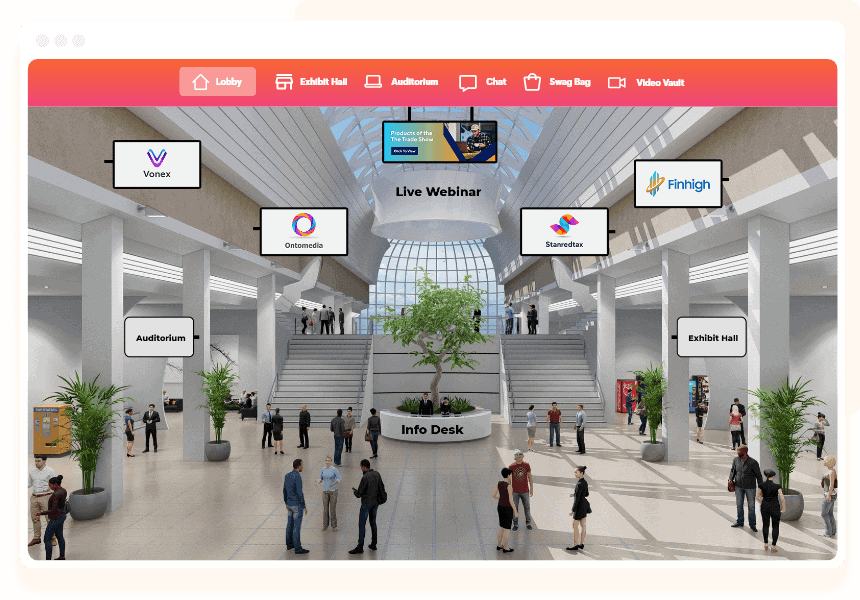
User-friendly Interface
To ensure a smooth virtual meeting, it’s crucial to choose platforms that are user-friendly and easy to navigate. vFairs all-in-one event management platform provides comprehensive end-to-end support and intuitive features that facilitate a seamless virtual environment.
Interactivity
What sets a successful virtual meeting apart is its level of interactivity. vFairs offers a plethora of features to make online meetings highly engaging. Live chats, Q&A sessions, trivias and polling features are among the standout engagement elements that encourage active participation and interaction.
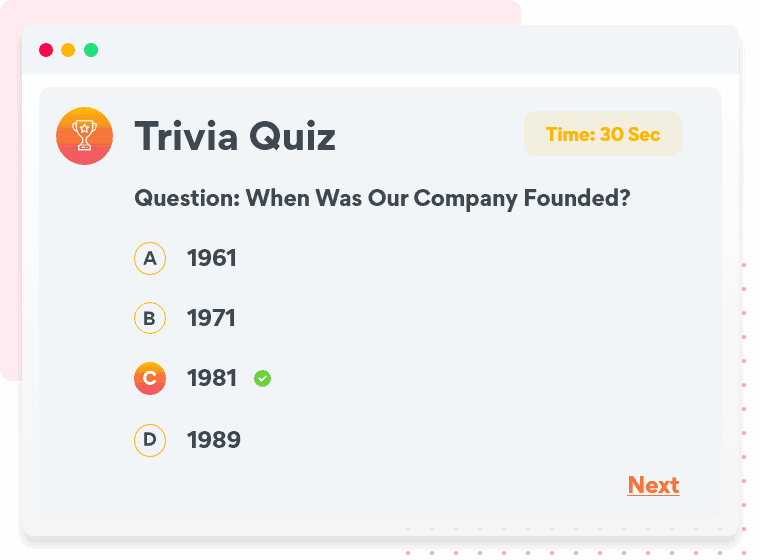
Social Media Integration
To elevate your virtual meeting’s interactivity, vFairs offers social media integration features that amplify your online presence. This feature allows you to integrate with social platforms and even highlights audience engagement using tools like walls.io.
Payment Integration
Every integrated feature serves a specific purpose and enhances the overall effectiveness of your event. vFairs’ payment integration simplifies the process of capturing payments during registration. The platform seamlessly integrates with PayPal and Stripe, offering a secure and convenient payment experience for your attendees.
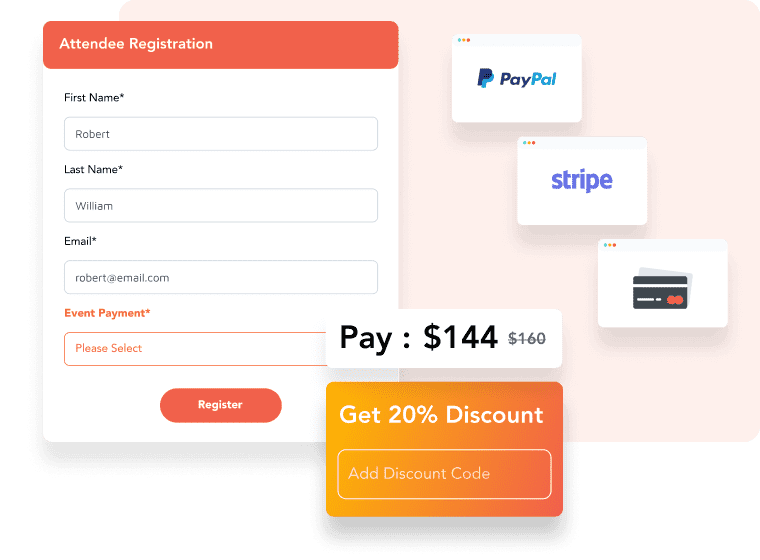
These are just a few of the many features available, with additional options such as sponsorship opportunities, event-building tools, virtual event marketing, gamification, and more. Leveraging these features can take your virtual meetings to the next level, creating engaging and memorable experiences for all participants.
Chapter 7: Virtual Meeting Engagement Ideas
Make sure you have some activities planned to keep your employees engaged. Here are some virtual engagement ideas to make virtual meetings more fun!
1. Virtual Ice Breakers
Icebreakers are a great way to get you and your participants to feel more relaxed and comfortable. Otherwise, you will have an audience that does not speak up. You can pose a question or have them share something about themselves. When people realize others are in the same boat as them, they ease up. Here are some suggested icebreaker activities for your virtual meetings.
Quick Round of Introductions
The easiest and most general way to get everyone to ease in is by doing a round of introductions. However, this is best only for when you are meeting for the first time. Prompt them to just say their names, and a quick intro to themselves. Add a twist by asking them to share a fun fact about themselves.
Hold a Trivia Game
Why not conduct an office trivia round? Break people into breakout rooms, and have them answer questions in a set amount of time. Whichever team gets the most answers right, wins!
Pro tip: Throw in gift cards as prizes for some added competition.
Share a Talent
You can either get individuals to simply share a talent or perform their talent, depending on their comfort level (don’t put them on the spot either). This can help them get to know one another better too.
What’s Your Spirit Animal & Why?
Share the definition of what a spirit animal is, and get everyone to think about it. Each then shares why they likened themselves to that specific animal. This is a good self-exploratory exercise for online meetings.
2. Virtual Scavenger Hunt
As part of your virtual environment, you can create a scavenger hunt. As people move between rooms in the virtual lobby or exhibition hall, make them keep an eye out for either the company logo, a company product, or anything under the sun! As they gather these, whoever finds the most wins!
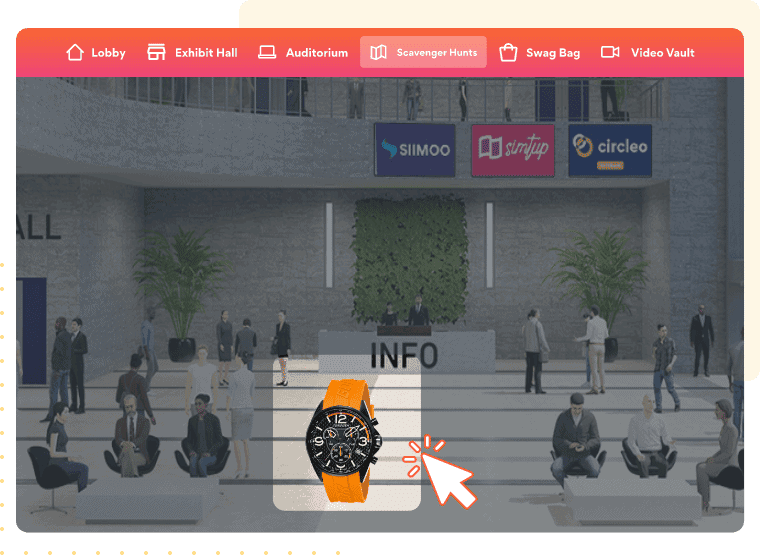
3. Virtual Leaderboard
If you have included a virtual scavenger hunt or trivia session, there can be a board that consolidates scores. Create friendly employee competition as they gather their scores and try to outdo one another. You can also allocate points to various activities in order to incentivize participation.
Pro-tip: Encourage employee engagement by providing gifts to the winner, second runner-up, and third runner-up.
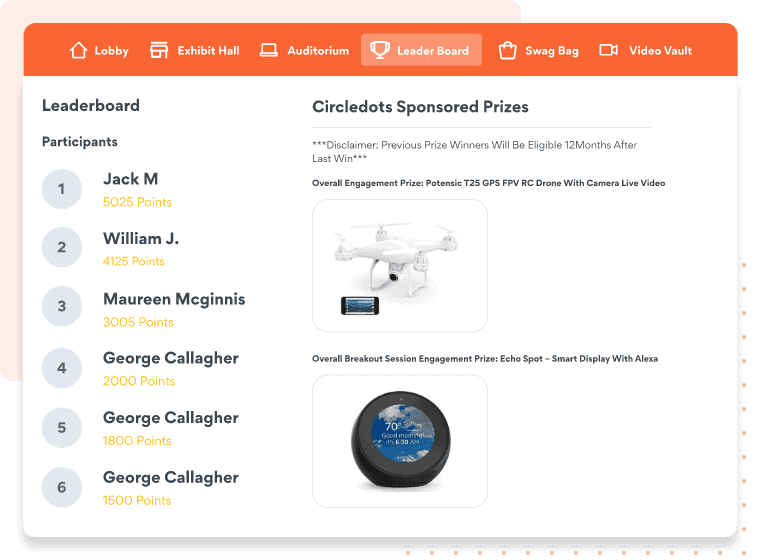
4. Mindfulness Meditation or Yoga Class
In today’s day and age, mindfulness and well-being are a great part of individual lives. Have a session between group meetings where people can relax or stretch it out. A more relaxed employee is bound to be a happier employee. Remember happy employees = happy customers.
5. Virtual Happy Hour
After a long day of meetings and brainstorming, why not end the day with a virtual happy hour? You can have gift boxes sent to your employees prior to the virtual session with a drink and ask them to hold onto them till the end of the day. Everyone can then join a group call, or relax in the networking lounge with a drink in hand and some friendly company.
6. Social Media Interaction
As part of the meeting, have your employees participate in social media activities. For instance, they can post an office activity they conducted onto their social media profiles, with a custom hashtag just for the virtual meeting. These posts will then show up on the social media wall within the virtual meeting. Have employees like their favorite ones and you can share a prize for those that did the best!
This will create wonderful engagement both before and during the meeting. It will break the ice, give your employees something exciting to do, and also show how inclusive your company is on social media platforms.
7. Host Quizzes & Contests
With integrations such as Kahoot, you can create fun games like quizzes and have employees compete against each other. Ask fun questions about the company or bosses. Your employees will find it a great way to unwind and relax whilst initiating friendly competition with their peers. Winners can get a company gift hamper.
8. Virtual Photo Booth
In the age of social media, everyone loves a friendly photo sharing their experiences. Why not bring a photo booth to your virtual meeting and have employees take group or individual photos together?

9. Breakout Rooms
Lest we forget, the meeting is happening for a reason. You are all trying to achieve a company goal. Breakout rooms are essential when you are having a company-wide call. You can make use of tools such as Miro Whiteboard in order to jot down everyone’s ideas in an interactive manner that can then be brought to the main meeting room.

10. Put The Employee First
Remember, you have to help make the employees feel they are an integral part of the organization. Think about what they would greatly benefit from. What would they truly enjoy as part of the meeting? Why not include them in the decision-making process?
Share a poll or survey prior to the event. Gather information that can help you create your agenda as well. Ask them what they would like to be included in the meeting. Maybe there are certain skill sets they would like to brush up on or acquire new ones. You can offer webinars with certifications at the end for this reason.
During the meeting, you can ask them to share their ideas or vision for the company in breakout sessions. They can do this using a miro whiteboard or create posters that can be displayed in the virtual poster hall. This activity will help them feel part of the company and thus more invested in achieving its mission and goals.
Chapter 8: Selecting the Right Virtual Meeting Platform
When it comes to selecting your virtual meeting platform, there are crucial factors to consider. Here are some key questions to help you assess whether a virtual meeting tool is the right fit for your needs:
1. Is the Platform Equipped for Company-Wide Calls?
You require a dependable software solution capable of supporting organization-wide meetings. It should handle multiple speakers and attendees seamlessly. Furthermore, in case of technical glitches or issues, there should be a responsive support team available to promptly address and resolve them.
2. Does the Platform Offer Engagement Tools?
As mentioned earlier, enhancing the employee experience is vital. The platform should offer engagement features, such as gamification or the ability to conduct company feedback surveys. These tools contribute to a more interactive and enjoyable virtual meeting experience.
3. Does it Offer More Than Basic Video Calls?
Beyond mundane video calls, consider platforms that provide a comprehensive virtual environment. These platforms often include integrations with popular software like Zoom and Microsoft Teams, offering additional features like virtual auditoriums, exhibition halls, networking lounges, and more. This expanded functionality enhances the overall meeting experience.
4. Does the Platform Provide Data Analytics?
Access to data analytics is crucial for assessing meeting performance. Can the platform provide insights into who attended the meeting, their geographical locations, the number of company representatives present, attendee profiles, and their feedback? Robust analytics help you gauge the impact of your virtual meetings.
5. Can Meeting Rooms be Personalized?
Tailoring meeting spaces to specific groups or individuals is important. Whether you’re organizing a company-wide town hall or a meeting exclusively for board members or stakeholders, the platform should allow you to create customized meeting rooms with restricted access, ensuring that only designated individuals can participate.
6. Does the Platform Offer Material Storage?
Recognize that not everyone may attend the meeting in real time. Therefore, it’s essential that your platform offers the capability to store and provide on-demand access to meeting materials. This includes webinars, PDFs, or any other resources you wish to distribute. These materials can be made readily available, even as part of a virtual “swag bag,” enhancing accessibility and post-meeting engagement.
By addressing these questions and considering these criteria, you can make an informed decision when selecting the virtual platform that best aligns with your specific meeting requirements, ensuring productive and engaging virtual gatherings.
Chapter 9: Key Features for Virtual Meeting Tools
In order to better understand what you should be looking for in platforms for virtual meetings, here is a quick rundown.
Single Button Sign-On
Participants can just click to log in or type in their email address to register for your meeting. This you can do by already having their information available from the back end of your company database. This ensures security and privacy.
Integrations
Is your company used to specific software? It would probably be best to make use of the same tools during your virtual meetings so that your employees don’t feel like they have to understand the entire platform when they arrive.
Whether MS Teams, Zoom, vFairs or any other, your virtual meeting platform should be able to provide you with these integrations. This software will have HD audio & video features so that you can effectively communicate during your meeting.
Networking – Direct & Group Messaging
Meetings require a lot of discussion, and there should be space for people to be able to do that. Be it a team meeting or 1:1 chats, you can have audio, video or text-enabled features for people to get talking.
Networking has become more efficient and easy within virtual platforms. Networking tools such as auto matchmaking align individuals with similar profiles. This can make it easy to form teams in breakout sessions.
Do you have meetings with outside stakeholders? With attendee profiles that have a virtual business card, you can now save attendees and export their information at the end of the event into an Excel sheet. All this makes networking so much more efficient and easier.
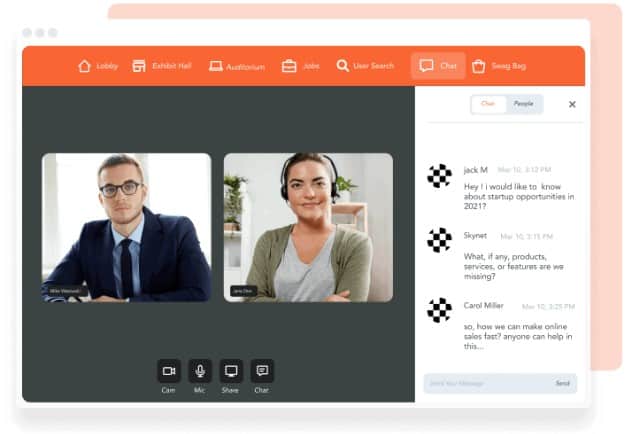
Recordings & Transcriptions
Various accessibility features will also make your meeting even easier. With consensual recording, you can be sure that individuals can find the meeting content available on demand. During the meeting, you can also have text size adjustments, inclusive visuals and closed captioning available. These tools are essential for ensuring that everyone has access to content.
Mobile App
Make sure your event is mobile-accessible. With the vFairs mobile app, you can be sure that your attendees will join from wherever they are. They can easily engage and network with other attendees through the mobile app. Webinars are also available on the go with the help of the mobile app.
Gamification
With gamification, you can make the experience so much more gratifying. During speaker sessions, you can hold interactive Q&As and polls or integrate with software such as Kahoot for an engaging experience. Within the event, you can have virtual scavenger hunts, a virtual leaderboard, trivia, and so much more.
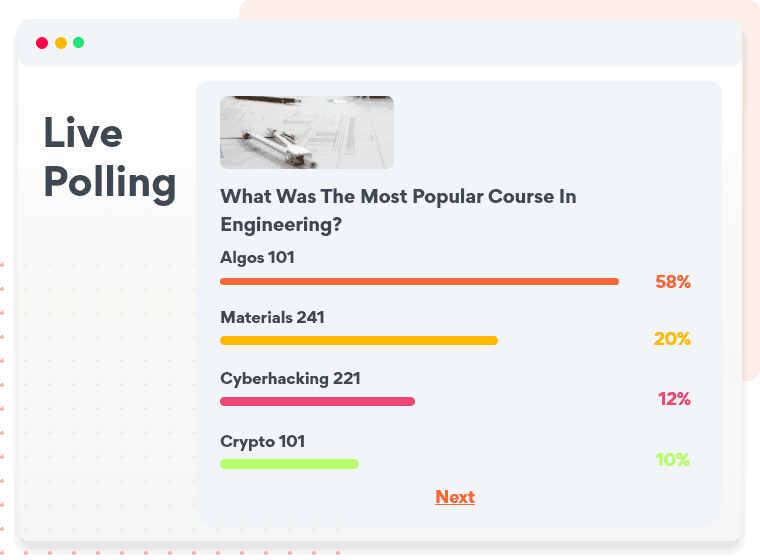
Chapter 13: vFairs for Virtual Meetings
By now, you may have developed an understanding of how hosting a virtual meeting is different from hosting a virtual session on Zoom. However, if you still need assurance about choosing vFairs as your next virtual platform to host seamless meetings, here’s what you need to know.
vFairs is a highly customizable virtual platform that offers a suite of tech solutions designed to elevate your virtual meeting experience. With vFairs, integration with your existing tech stack is effortless, delivering unparalleled value across the board. You can use AI-driven matchmaking to connect with like-minded individuals. Participants can engage in one-on-one and group audio, video, and text chats. Cutting-edge features like breakout rooms and roundtables enhance networking at your virtual meeting.
Virtual attendees can enjoy an immersive virtual environment complete with exhibit halls, webinars featuring multi-track agendas, networking and matchmaking tools, gamification elements, and other audience engagement features.
The platform’s user-friendly setup, comprehensive demo videos, and up-to-date knowledge base make virtual meetings a breeze and empower you to unlock the full potential of this powerful platform.
Want to know more about vFairs? Book a demo now.
FAQs
How to set up a virtual meeting?
Setting up a virtual meeting involves selecting a suitable platform, scheduling the meeting, sharing invitations, defining the agenda, and testing the technology beforehand. Detailed instructions may vary depending on the chosen virtual meeting tool.
How to start a virtual meeting?
Begin by launching the virtual meeting software or platform you've chosen. Log in if required, then create or join the meeting using the provided meeting ID or link. You'll typically need to ensure your audio and video settings are configured correctly.
How to conduct a virtual meeting?
Effective virtual meeting conduct involves setting clear objectives, engaging participants, managing time efficiently, and fostering collaboration. Ensure you have a structured agenda, encourage active participation, and maintain focus on the meeting's goals.
How to do a virtual meeting?
Before conducting a virtual meeting, you should plan an agenda, confirm technical requirements, invite participants, and familiarize yourself with the meeting platform. During the meeting, stick to the agenda, facilitate discussions, and maintain engagement.
How is a business virtual meeting beneficial?
Business virtual meetings offer advantages such as cost savings, increased flexibility, and improved accessibility. They enable organizations to connect with remote employees, clients, and partners efficiently, enhancing collaboration and productivity.
Which of the following is the simplest form of virtual meeting?
The simplest form of a virtual meeting is often a one-on-one video call or a small group discussion conducted through basic video conferencing tools or chat applications. These meetings involve minimal setup and are easy to initiate for direct communication.


